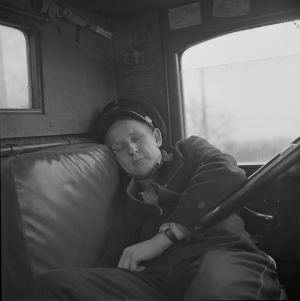When the truck became a viable means of intercity freight transport in the U.S. post-World War I, truck drivers hit the road and didn’t look back.
The fledgling trucking industry became notorious for drivers who would take whatever load they could get as far as they could, hopefully without falling asleep and running off the road, sleeping when and where they could.
By the 1930s, the push was on to limit on the amount of time truckers could spend behind the wheel, first at the state and then the federal level. The Motor Carrier Act of 1935 ordered the Interstate Commerce Commission to regulate truck driver hours of service, and the first federal rules were issued in 1938.
Truck driver fatigue and hours of service are still major issues today — the Federal Motor Carrier Safety Administration, which oversees trucking and promulgates safety rules, began enforcing updated HOS regulations for truckers July 1, 2013 that cut into the hours they can spend behind the wheel.
This article was published in the Jan. 26, 1935 issue of The Traffic World.
Hour Limits For Truck Drivers
Under the title “Too Long at the Wheel,” the National Safety Council has issued a report dealing with fatigue among drivers of motor vehicles. The report is the result of studies made in each state, supplemented by personal investigations by two council engineers. It shows that 1 percent of all automobile accidents occur while the driver of the car is asleep or extremely fatigued, as compared with 3.2 percent attributable to intoxication or partial intoxication, 5.1 (percent) to defects in the vehicle or equipment and 0.7 of 1 percent “struck or struck by railroad train.”
In a summary of the report, the council points out that “violations of these rules (limiting hours of consecutive driving in most states) are most common and serious in long-haul for-hire trucking, particularly among drivers who own their own vehicles; although flagrant offenses occur in other types of trucking and are not uncommon in some kinds of bus operations.”
So far as regularly run common carrier truck fleets are concerned, the council says that many “have already adopted safety measures voluntarily, and the only effect enforced legislation on hours and duty will have on them is to reduce competition from, and chance of collision with trucks whose drivers are working dangerously long hours.”
Conclusions reached from the study are embodied in a series of “general recommendations.” The council recommends that the element of fatigue be given more importance in accident reports, that a scientific study be made to determine what effect continuous driving, long hours without sleep and mechanical aspects of vehicles have on fatigue and to ascertain the recuperative value of various rest periods, and that fleet operators and private owners voluntarily organize their businesses to avoid excessively long hours on duty for drivers.
All states, the council recommends, should limit the hours on duty of all except the drivers of private cars, that limitation to cover total working and waiting time, not merely time spent at the wheel. “There is need,” the report says, “for agreement among the states as to what constitutes time on duty and the conditions under which rest may be obtained.” After such laws have been made, the report said, a definite procedure for their enforcement should be laid down.
Finally, the report recommends that truck operators adopt a system of trip records so that these records may show the exact conditions under which their drivers are working.
** 30 **
Click here for a slideshow on the history of truck driver HOS rules I created for The Journal of Commerce.
— wbc

